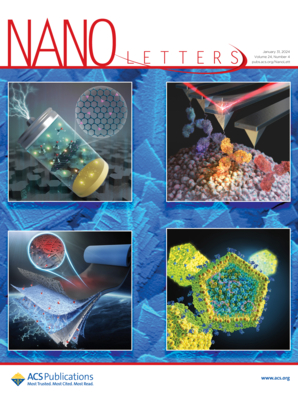Operando Hydroxylation of the Sn-Co Diatomic Catalyst Boosting Ultrastable Zn-Air Batteries.
IF 9.1
1区 材料科学
Q1 CHEMISTRY, MULTIDISCIPLINARY
引用次数: 0
Abstract
Diatomic catalysts (DAs) exhibit superior catalytic activity for the oxygen reduction reaction (ORR) due to the synergistic interplay between dual metals. However, their dynamic evolution remains unexplored under the working conditions. Herein, Sn-Co diatomic pairs on N-doped carbon with an asymmetric N3Sn-CoN3 structure (SnCoN6 DA) are rationally designed for promoting ORR activity and durability. The operando hydroxylation of SnCoN6 DA regulates O2 adsorption on Co, allowing more d orbitals to hybridize with O2 s/p orbitals. Furthermore, the *OH-Sn moiety serves as an electron modulator that upshifts the d-band center of Co, enabling stronger binding with *OOH and expediting subsequent O-O cleavage. Accordingly, the operando hydroxylation of SnCoN6 DA positively shifts the half-wave potential by 54 mV and enhances the kinetic current density by 16.1 times compared to those of the Co single-atom catalyst. The constructed Zn-air battery shows an ultralong cycling life span (more than 3650 h at 5 and 10 mA cm-2).Sn-Co双原子催化剂的操作羟基化促进超稳定锌空气电池。
由于双金属间的协同作用,双原子催化剂在氧还原反应(ORR)中表现出优异的催化活性。然而,它们在工作条件下的动态演变仍未被探索。为了提高ORR活性和耐久性,合理设计了n掺杂碳上具有不对称N3Sn-CoN3结构(SnCoN6 DA)的Sn-Co双原子对。SnCoN6 DA的operando羟基化调节Co对O2的吸附,使更多的d轨道与O2 s/p轨道杂化。此外,*OH-Sn部分充当电子调制器,使Co的d带中心上移,使与*OOH的结合更强,并加速随后的O-O裂解。与Co单原子催化剂相比,SnCoN6 DA的operando羟基化使半波电位正向移动了54 mV,使动力学电流密度提高了16.1倍。所构建的锌空气电池具有超长的循环寿命(在5和10 mA cm-2下超过3650小时)。
本文章由计算机程序翻译,如有差异,请以英文原文为准。
求助全文
约1分钟内获得全文
求助全文
来源期刊

Nano Letters
工程技术-材料科学:综合
CiteScore
16.80
自引率
2.80%
发文量
1182
审稿时长
1.4 months
期刊介绍:
Nano Letters serves as a dynamic platform for promptly disseminating original results in fundamental, applied, and emerging research across all facets of nanoscience and nanotechnology. A pivotal criterion for inclusion within Nano Letters is the convergence of at least two different areas or disciplines, ensuring a rich interdisciplinary scope. The journal is dedicated to fostering exploration in diverse areas, including:
- Experimental and theoretical findings on physical, chemical, and biological phenomena at the nanoscale
- Synthesis, characterization, and processing of organic, inorganic, polymer, and hybrid nanomaterials through physical, chemical, and biological methodologies
- Modeling and simulation of synthetic, assembly, and interaction processes
- Realization of integrated nanostructures and nano-engineered devices exhibiting advanced performance
- Applications of nanoscale materials in living and environmental systems
Nano Letters is committed to advancing and showcasing groundbreaking research that intersects various domains, fostering innovation and collaboration in the ever-evolving field of nanoscience and nanotechnology.
 求助内容:
求助内容: 应助结果提醒方式:
应助结果提醒方式:


